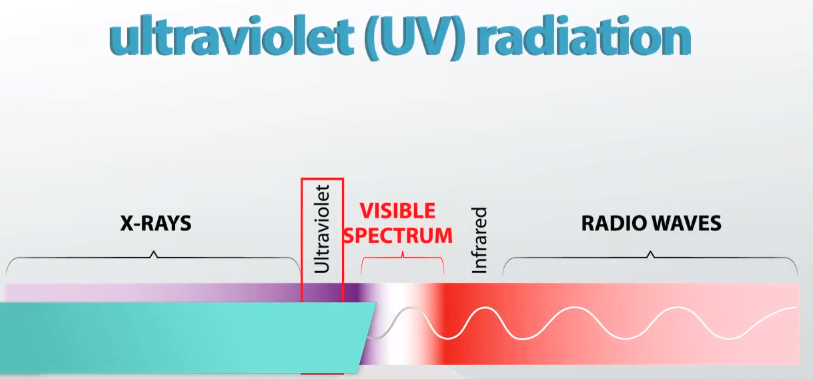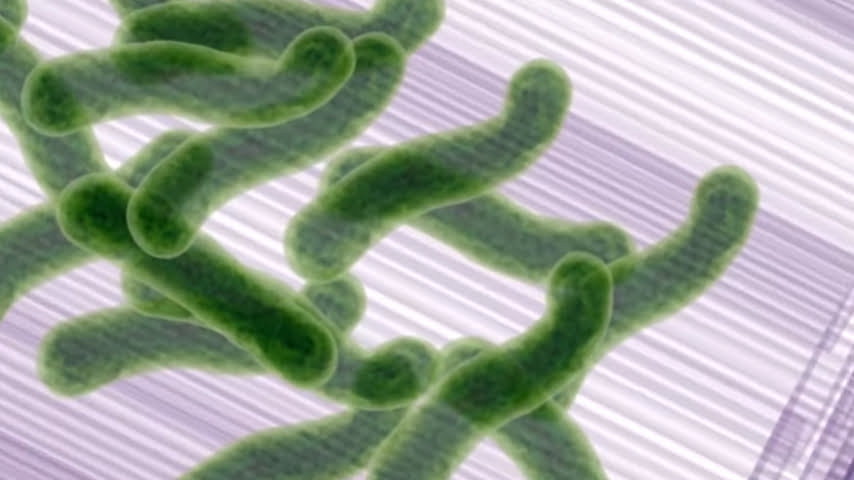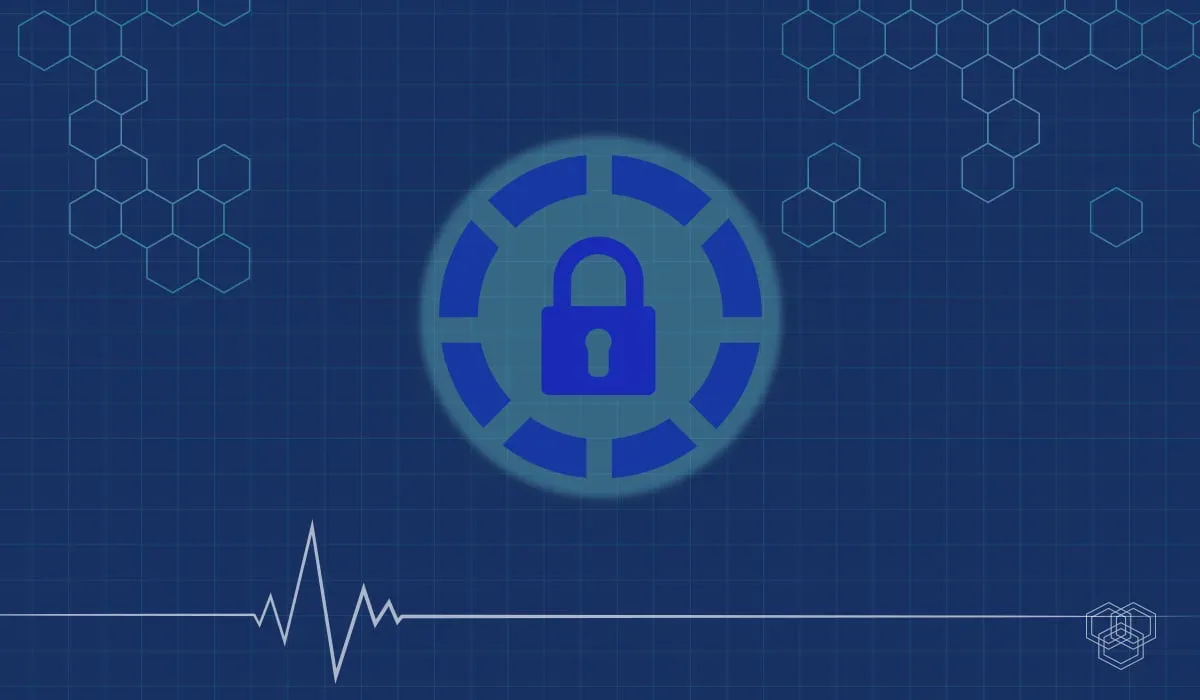Ultraviolet light is a type of electromagnetic radiation.
Ultraviolet light, including both UVA and UVB, is the main cause of both summer tans and sunburns. The effects of UV radiation on the human body can be quite detrimental, and it is important to take precautions to protect the skin. Excessive exposure to ultraviolet rays can lead to premature aging, wrinkling, and even an increased risk of developing skin cancer. It is therefore crucial to always be mindful of sun protection methods such as wearing broad-spectrum sunscreen, seeking shade when the sun is at its strongest, and wearing protective clothing, hats, and sunglasses. Keeping in mind that UV radiation can be damaging to the living tissue, it is essential to strike a balance between enjoying the sunshine and preserving our health.
Ultraviolet light is not detectable by the human eye. But some insects are able to see ultraviolet light. Our bodies use ultraviolet light to make vitamin D. If the ultraviolet light exposure is too much, then it can be very harmful as it can cause cancer.
When Ultraviolet light descends on certain materials, ultraviolet light may cause them to fluoresce. It emits electromagnetic radiations of lower energy, such as visible light. Ultraviolet light, when it interacts with specific substances, has the ability to induce fluorescence. This phenomenon occurs due to the emission of electromagnetic radiations of lesser energy, such as visible light.
Table of Contents

The range of ultraviolet light:
Ultraviolet radiation lies between wavelengths of about 400 nanometers (1 nanometer [nm] is 10−9metre) on the visible-light side and about 10 nm on the X-ray side, though some authorities extend the short-wavelength limit to 4 nm.
Regions in which ultraviolet light is divided:
Ultraviolet radiation is commonly divided into four regions:
- near (400–300 nm)
- middle (300–200 nm)
- far (200–100 nm)
- extreme (below 100 nm)
Divisions of ultraviolet light:
Based on the interaction of wavelengths of ultraviolet radiation with biological materials, three divisions have been designated:
1. UVA (Ultraviolet A): This is the longest wavelength among the three divisions, with a 320 to 400 nanometers range. UVA radiation penetrates the deepest into the skin and is mainly responsible for aging and wrinkling. It is also the type of UV radiation used in tanning beds.
2. UVB (Ultraviolet B): With a range of 280 to 320 nanometers, UVB radiation affects the skin’s surface layers. It is the primary cause of sunburns and is a major contributor to the development of skin cancer. UVB rays are strongest during midday when the sun is at its highest point in the sky.
3. UVC (Ultraviolet C): This is the shortest wavelength of the three divisions, ranging from 100 to 280 nanometers. Fortunately, UVC radiation is mostly absorbed by the Earth’s atmosphere and doesn’t reach the surface. It is highly germicidal and is commonly used for disinfection purposes.
Understanding the different divisions of ultraviolet radiation is crucial for protecting ourselves from its harmful effects. By taking precautions such as wearing sunscreen, protective clothing, and avoiding excessive sun exposure, we can minimize the risks associated with UV radiation.
How ultraviolet light is produced?
High-temperature surfaces, such as the Sun produce ultraviolet radiation.
It is produced in a continuous spectrum and by atomic excitation in a gaseous discharge tube as a discrete spectrum of wavelengths.
Most of the ultraviolet radiation in sunlight is absorbed by oxygen in the Earth’s atmosphere, forming the lower stratosphere’s ozone layer. This layer of ozone acts as a shield, protecting life on Earth from the harmful effects of excessive UV radiation. It is important to note that the ozone layer absorbs the majority of the sun’s UVB radiation, which is known to be more damaging to living organisms. However, of the ultraviolet that does manage to reach Earth’s surface, almost 99 percent is UVA radiation. UVA rays are less energetic than UVB rays, but they still have the potential to cause skin damage and contribute to the aging process.

An ultraviolet UV lamp
An ultraviolet UV lamp has been developed that basically kills the influenza virus. A study has shown that it is not injurious to human eyes, skin, and health.

Objective:
This sophisticated technology has been developed with the primary objective of intercepting the transmission of seasonal flu in various public settings, including but not limited to schools, hospitals, restaurants, libraries, offices, parks, stores, and many more. It is worth noting that ultraviolet light, renowned for its exceptional effectiveness and efficiency, plays a pivotal role in eradicating germs, microbes, bacteria, and viruses, thereby contributing significantly to public health and safety.
UV devices:
There are UV devices that have been widely utilized for the purpose of sterilization and ensuring the cleanliness of medical equipment within hospital premises. With their ability to effectively eliminate harmful microorganisms, these UV devices play a vital role in maintaining a hygienic environment in healthcare settings. By utilizing ultraviolet technology, these devices have proven to be invaluable tools in safeguarding the health and well-being of both patients and medical professionals.
But the conventional germicidal lamp is not safe for humans when they are around.
Can Coronavirus be killed with UV Light?
There’s only one type of UV that can reliably inactivate Covid-19 – and it’s extremely dangerous.
BBC.com
According to BBC.com and some researchers, it’s not a good idea or even impossible. Learn more here.
UV light can effectively kill airborne influenza:
UV light has been proven to be highly effective in eliminating airborne influenza. This powerful tool can successfully eradicate bacteria while still ensuring the safety of human tissues. A study conducted by experts, as mentioned in the linked article (source), provides evidence that broad-spectrum germicidal UV light, with wavelengths ranging from 200 to 400 nanometers, is remarkably successful in eradicating bacteria, microbes, and viruses. This process occurs by disrupting the molecular bonds responsible for holding the DNA together. With these impressive findings, it is clear that UV light is a valuable tool in the fight against the spread of influenza.
This conventional UV light is used to sterilize medical equipment. The conventional germicidal UV is also harmful to human health. It can cause skin cancer.
Brenner and his colleagues hypothesized that a narrow spectrum of ultraviolet light called far-UVC could destroy microbes without damaging healthy tissue.
UVC light has a very limited range, and it cannot go through the outer dead cell layer of human skin or the tear layer in the eye. However, it is not harmful to human health.

Conclusion:
Ultra-violet rays can provide numerous benefits of sterilization, i.e., removing microbes and viruses from the equipment. Additionally, they have the capability to effectively reduce the transmission of illnesses caused by these harmful pathogens. Notably, there is a special emphasis on the transmission of the influenza virus; however, the practical application of ultraviolet rays extends beyond eradicating these viruses. The utilization of UV rays is instrumental in rendering equipment free from microorganisms and viruses, thereby significantly minimizing the risk of infectious diseases.
Affiliate Disclaimer: TechEngage participates in the Amazon Services LLC Associates Program. As an Amazon Associate, we earn from qualifying purchases through links to Amazon.com and its affiliated sites. For more information, please read our disclaimer.





Great article. The use of UV light has lead to the saying that “sunlight is the best disinfectant.” And as to viruses, it is obvious that during summer seasons globally, the incidence of flu and colds is profoundly reduced. These seasons of course, are those in which the people go outside to soak up some sun. UV exposure from sunlight or sunlamps is also used to disinfect water, toothbrushes and even blood. I love articles that tell the truth about sunlight and UV light in general.
For more information and references: sunlightinstitute.org. Or, read Dr. Marc Sorenson’s new book, Embrace the Sun, available at Amazon.
Whether ultraviolet lamp kill covid-19.
Whether x-ray will kill covid19.how to make a x-rays in house as ultraviolet bulb or emissions.is there is any way to make our normal electric arc bulb to emit ultraviolet or x-rays.iam from country India .
To Balachandar, there was a device that emitted low power x-rays (next in the spectrum to biocidal UV) in almost all homes throughout most of the world – the CRT television. The later models of CRT TV and computer monitors were engineered to emit less of this germicidal radiation, and the flat screen TVs that replaced them don’t emit any. The high voltage in CRT TVs may also have produced ionisation of the air which also potentially degrades virus.
Can blk light / UV Light 365nm kill bacteria and Viruses? Also is there a height the UV light should be positioned in order to kill the bacteria / viruses ? Thanks
Mr.Lee are you now in China.please immediately email me .
ravi4u2983@gmail.com.
I need your help
Mr.lee if you in China i wish to know about corona to try for protection we will both do try .
Can U V be used to sterilize disposable N95 masks for reuse
Did you receive a response? Can UV be used to sterilizer disposable N95?
I would like to know that too!
How long an exposure (minutes or hours) are these UV lamps effective in killing viruses?
How many Watts are necessary?
My exact questions as well!
How long an exposure (minutes or hours) are these UV lamps effective in killing viruses?
How many Watts are necessary?
It appears to be more about the intensity of the bulb. This site has a great chart that might give you an idea https://www.americanairandwater.com/uv-facts/uv-dosage.htm
No direct response to using U V to
Sterilize N45 masks – cdc
Any facilities that could respond
And help hospitals on front lines
Until surplus of N45
I am not medically trained in any way, but if uv can kill covid 19 could a endoscope
possibly be developed and used, using uv light, to treat covid 19 patients lungs thus killing the virus?
A couple of months ago, I purchased a bulb from China, after reading of the ability of the UV C being able to clean the air of mold and bacteria. I recently put the bulb in my back room, a room that I once used for a computer repair shop, but have since given up on that hobby. It is in a goose neck light, and aimed at the ceiling. I know it works as I can smell the ozone that it produces, and the black-light effect is obvious as well. I am thinking of moving that light around my home from room to room and allowing it to run for 30 minutes in each room to clens the air and surfaces. Do you see any danger in this process, so long as I keep everyone and the cats that live in our home away from the rooms being processed?
My search landed me into your site looking for info. The current understanding is that UV C (280-100nm) is effective in killing virus like covid 19
However you have indicated 200-400 nm. Bit confused